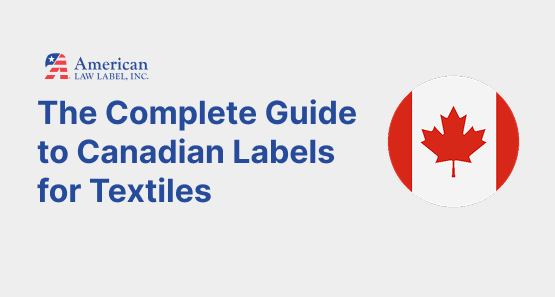
Our name might be “American” Law Label, but we also know Canadian labels like the back of our hand, too! Partner with us, and you can have both U.S. and Canadian labels designed and printed at the same time by the same team.
Here’s a quick rundown of the Canadian government’s requirements for labels, use of the French language, exempted products, and further reading.
Want to get the inside scoop on Canadian labels? RSVP for our sister company GRS’ upcoming webinar!
Canadian Labeling Requirements
The Canadian Federal government requires labeling of textile articles, including stuffed textile articles. Depending on the type of product, Canadian labels can either be a permanent label able to withstand 10 cleanings, or a non-permanent label such as a hang tag or sticker.
At minimum, the label must disclose two pieces of information: the dealer identity, and the fiber content and percentages of the product.
Dealer Identity
The Canadian government defines a product’s dealer as “the person who is a manufacturer, processor, finisher or retailer of a textile fibre product, or a person who is engaged in the business of importing or selling any textile fibre product” (IV. Definitions, 1. Dealer).
To identify the dealer, your product’s label must either include a Canadian identification number (CA number) or the dealer’s name and full postal address.
Fiber Information
Canadian labels must also disclose the product’s fiber content and percentages.
There are three components that must be considered when determining an article’s fiber content: outer covering/shell, findings, and stuffing/filling. Requirements for disclosing each part of an article differ by product type.
- Outer Covering/Shell: Must always be disclosed.
- Findings: Textile fiber parts added to a product for a functional purpose (other than filling or providing warmth) do not need to be disclosed. However, if any claims are made of that fiber, then the fiber must be disclosed on the label.
- Stuffing/Filling: Must be disclosed for products not exempted below. However, if any claims are made of a filling in an exempted product, that information must be disclosed on the label.
- Exemptions: Mattresses, box-springs, cushions, chair pads, pot holders, oven mitts, placemats, mattress protectors, or upholstered furniture
Fiber information must be presented in both English and French. The province of Quebec may require additional language translations outside of the scope of the Canadian Textile Laws.
Quebec Translations
In 2022, the province of Quebec passed Bill 96, a law which amended the Charter of the French Language to require that labels, packaging, and product inscriptions be available in French.
Specifically, Quebec requires that all products sold in the province are labeled in French, and that the use of French is given equal prominence with other languages on any packages or containers.
This requirement applies to all product inscriptions, including care instructions, marketing information, and labels.
The American Law Label team personally contacted Quebec’s Office of the French Language to inquire about any exemptions to this requirement. The office’s response was that every inscription on a product or its packaging, including labels, must be available in French in the same terms.
That means essentially all product inscriptions must be translated into French, including care labels, law labels, flammability labels, and others.
When you partner with American Law Label for Canadian labels, we will thoroughly translate your English-language labels into French. It’s a simple way to ensure that your labels will meet the requirements in both the United States and Canada in one easy transaction.
Product Exemptions
There are a handful of consumer textile articles that are exempt from the requirements of the Textile Labelling Act and Regulations.
Some highlights include:
- Articles intended for a one‑time use only
- Toys
- Sports and games equipment other than sport garments
- Playpens, crib‑pens, strollers, jumpers, walkers and car seats for infants or children
- Pet accessories
You can find the full list of exempted products in Appendix E of the Guide to the Textile Labelling and Advertising Regulations.
Canadian Labeling Resources
Here are a couple resources from the Canadian government’s website that dig deeper into their labeling requirements.
Guide to the Textile Labelling and Advertising Regulations:
Quebec Charter of the French Language:
RSVP for Our Canadian Labels Webinar
A great way to learn more about Canadian labeling requirements is to attend the Canadian Labels webinar hosted by our sister company, Global Registration Services.
The next session as of publishing is on September 17, 2025. RSVP using the button below to reserve your seat!
If you can’t make it to the next session, GRS hosts a Canadian Labels webinar every quarter. See the full lineup of future webinars here.
Stay up-to-date with American Law Label
"*" indicates required fields





